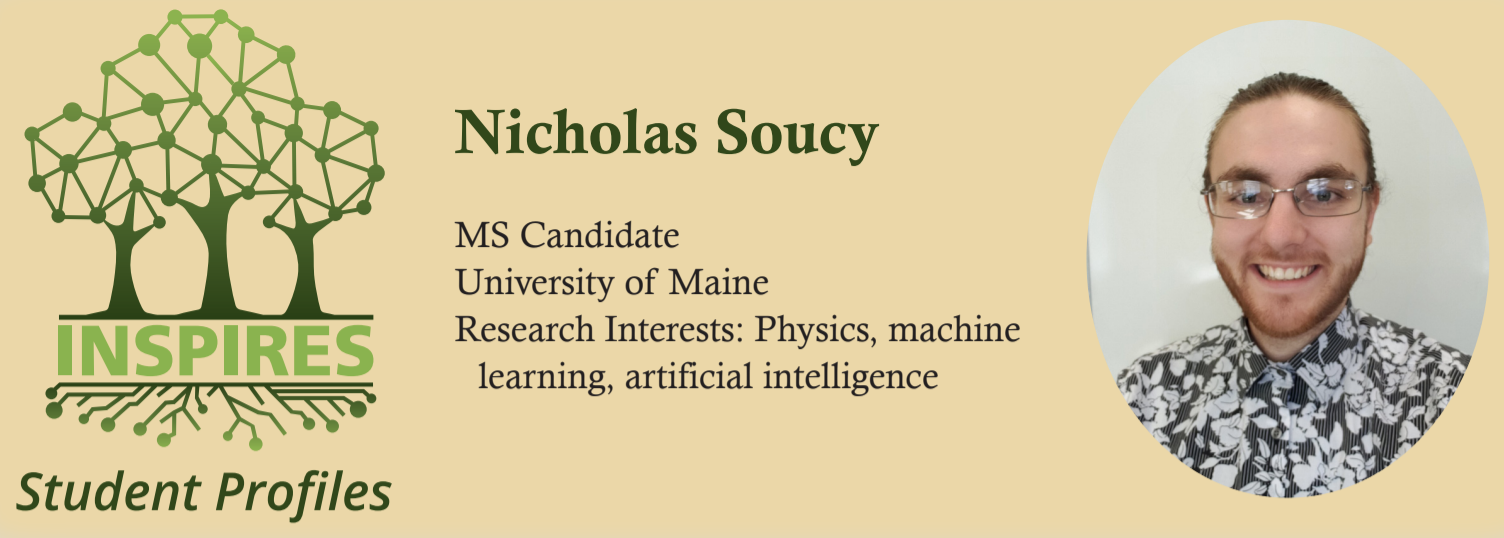
INSPIRES Student Profile: Nicholas Soucy
By Stefania Irene Marthakis
Nicholas Soucy is continuing his University of Maine education as a M.S. candidate in Computer Science, working across fields such as physics, machine learning (ML), and artificial intelligence (AI). With a B.A. in Physics from the University of Maine, Soucy received the Center for Undergraduate Research (CUGR) and the Maine Space Grant Consortium (MSGC) Academic Year 2019-20 Fellowship for research related to his THED: Thermal Hand Experience Device.
Currently, Soucy is advised by Salimeh Yasaei Sekeh (an assistant professor in the School of Computing and Information Science a the University of Maine). Soucy also works as a research assistant in The Sekeh Lab, which focuses on theoretical and practical aspects of ML as well as designing algorithms and deep learning techniques.
“I love working in ML because I can see the future of humanity within it. It’s beautiful to see the far-reaching applications ML has on our day-to-day lives from manufacturing to self-driving cars. I believe this technology can save and make lives better. It is an honor to propel the field forward,” Soucy states.
Since Soucy was already working with similar machine learning tasks—i.e., using neuroscience and math to define what animal or human brains do, and then teaching a computer to recognize patterns or trends within that large data—it was fitting for Soucy to work with Sekeh within the multidisciplinary project of INSPIRES as part of Theme 2.

“In our ML-INSPIRES project,” Sekeh explains, “we explore deep network approaches for large-scale hyperspectral images (HSI), which are a relatively new remote sensing scheme in forestry and climate change sciences. We develop novel ensemble methods to segment images into tree species. Furthermore, because computational complexity is a prominent challenge in deep network-based algorithms, in this work, we intend to investigate techniques that reduce HSI dimensions and extract informative features as a preprocessing step of our classification/segmentation models.” Sekeh continues, “Soucy plays a key role in our ML-INSPIRES project and he has been an active researcher in The Sekeh Lab working on ideas that develop bridges between deep learning and hyperspectral data sets.” Originally from Maine, Soucy is excited to apply his models—using data sets that were created by INSPIRES researchers, data sets that had been lacking— to New England forests through this National Science Foundation EPSCoR program.
“I’m developing a model that can take in hyperspectral data (data of large areas of land with many wavelengths of light) then reducing the dimensionality of the data so that the images are smaller and therefore, reduces the computational complexity of the data set. Then, we classify tree species and ground types, so that people can know where certain trees are or certain plants are, based on imagery from the sky,” Soucy explains.
This summer, Soucy is also looking forward to writing and completing a paper on his research from this past year on tree species classification ML techniques. The interdisciplinary approach of the INSPIRES project, from advanced sensing to smart environmental informatics, has provided Soucy with the opportunity to grow in the emerging field of ML.
